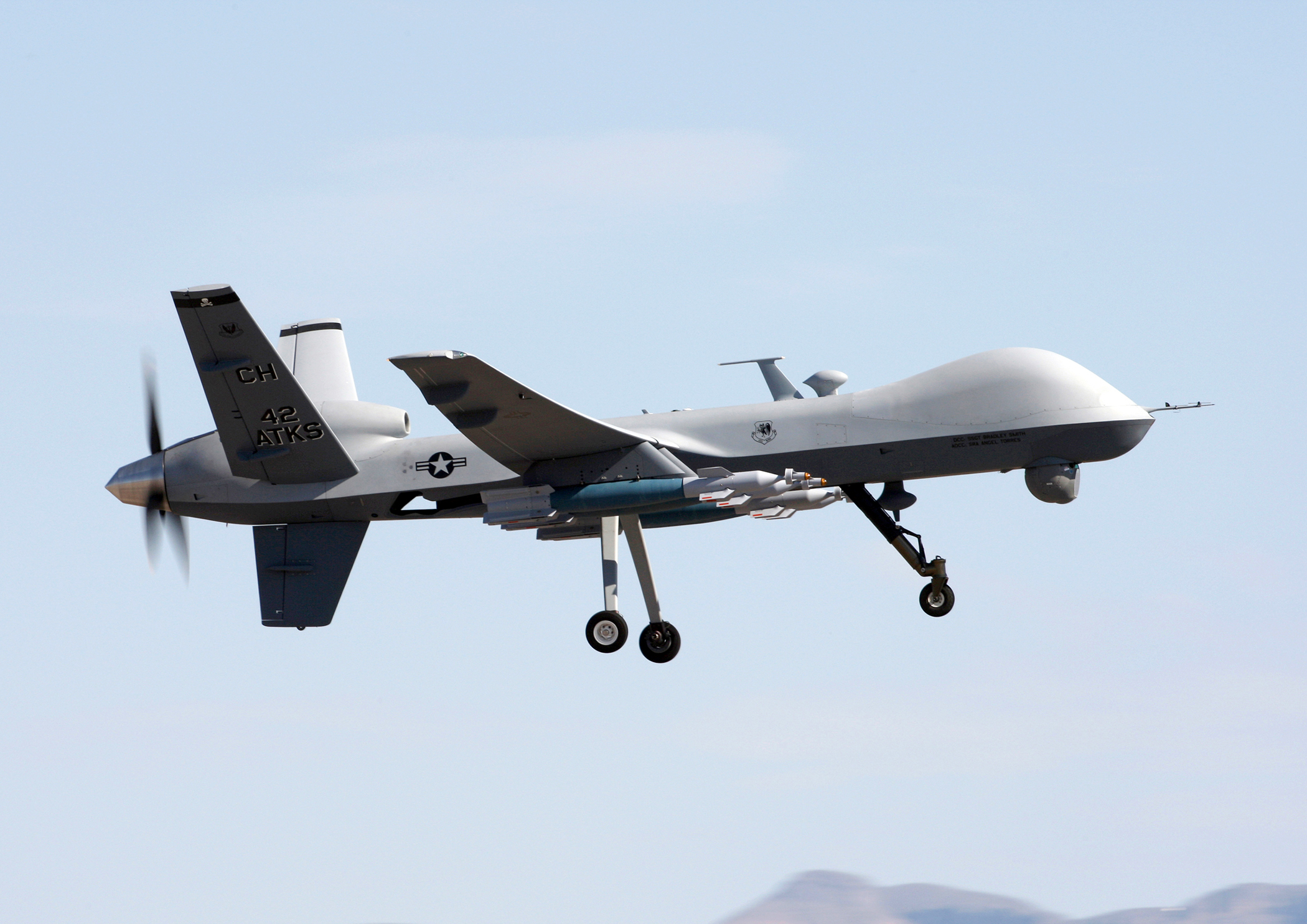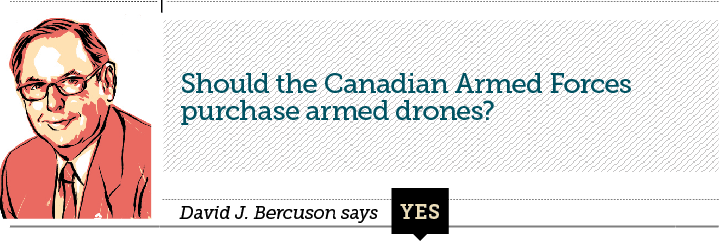Canada is shopping for a new fleet of technologically advanced drones, also known as remotely piloted vehicles (RPVs) or unmanned aerial vehicles (UAVs). Chief of the Defence Staff General Jonathan Vance has called for these drones to have an armed capability. He is right. For Canada to buy these aircraft without the ability to carry missiles makes as much sense as it does to order our new fighter jets without guns, missiles or the capacity to carry bombs.
The first RPVs were used by the Luftwaffe in the Second World War to attack Allied warships. Radio guided from a German bomber, they destroyed a number of Allied ships. HMCS Athabaskan, a Canadian destroyer, was seriously damaged by one in August 1943. Since the 1980s they have become ubiquitous with all the world’s advanced militaries. Canada acquired a small number of them for reconnaissance purposes in the late 1990s. Those French-built, rail launched Sperwers were found to be obsolete for use in Afghanistan and were replaced by Israeli-built Herons, leased through a Canadian company. The Canadian Herons had no armed capability and were used solely to gather information on the enemy’s whereabouts and, presumably (because it is still a secret), to “spot” targets for Canadian or other NATO artillery or air support.
Today RPVs range in size from small hand launched devices, not unlike flying model airplanes that can be purchased at any hobby store, to the Global Hawk, an RPV built by the United States that is the size of a small passenger aircraft with a range of 22,000 kilometres, a speed of just less than 640 kilometres per hour and a service ceiling of 60,000 feet. Virtually all of the military RPVs are used in some form of spying on the enemy. But some, such as the U.S. Predator, carry missiles. These RPVs can be used to support ground forces in a variety of ways from locations as far removed as the Nevada desert. They have also been used with increased frequency by the U.S. (and presumably other countries) to conduct targeted killings.
U.S. President Barack Obama has made targeted assassination by RPVs a central tenet of U.S. Special Operations, with mixed results. Many insurgent leaders have been killed, but many innocent civilians have also died and that has created controversy about both the legal and moral implications of using “flying robots” to kill people. There are, thus, Canadians who oppose acquiring RPVs capable of being armed.
U.S. President Barack Obama
has made targeted assassination by RPVs
a central tenet of U.S. Special Operations.
But neither the Canadian government nor the Canadian Armed Forces follows any such doctrine. Canada does not do targeted killings. For Vance and the CAF, there is a simple question: should Canadian RPVs be armed so they can fly close support missions for Canadian soldiers on the ground, no matter whether those forces are engaged—in peace enforcement operations or small wars—or not?
If Canada purchases RPVs that have no armed capability, a situation is sure to unfold where a Canadian RPV operator looks down from his perch hundreds or even thousands of kilometres away and watches helplessly as Canadian soldiers are ambushed. If Canada’s RPVs do have capability to launch missiles, that same RPV operator can not only warn his comrades on the ground of an impending ambush, he’ll be able to help them fight the enemy off. That capability is perfectly legitimate in warfare and the CAF ought to have it.

There is no surprise in a defence chief wanting drones and wanting them armed, but to insist, as has General Jonathan Vance, that “there is little point to having a UAV that can see a danger but can’t strike it,” seems at best odd. After all, the list of military systems that are very good at seeing danger without having any capacity to strike at it includes some pretty key items.
The CP140 Aurora surveillance aircraft does carry a torpedo in its anti-submarine role, but that is its only strike capacity, and a torpedo brings nothing to its sovereignty patrols, surveillance missions, or search and rescue assistance. Satellites, coastal radars, or underwater surveillance in the Arctic are certainly not rendered pointless by the absence of a strike capacity.
Given the decades-long, post-Cold War consensus that there is no military threat to Canadian sovereignty and territorial integrity, the real security need is not for defence in that sense, but for effective intelligence and surveillance in aid of civilian regulatory, law enforcement, and emergency response authorities.
Indeed, when military monitors now detect threats to public safety and well-being, the Department of National Defence is rarely the lead response agency. When coastal radars, for example, detect unauthorized aircraft, which for more than a half century have overwhelmingly been civilian, the response, sometimes assisted by interceptions with military aircraft, falls to civilian police. The Russian strategic bombers that visit international air space adjacent to North America from time to time are the exception, but they represent no military danger and striking at them is definitely not in NATO’s peacetime playbook.
In the maritime environment, the Coast Guard and Department of Fisheries and Oceans are the lead agencies when surveillance points to breaches of Canadian regulations and laws, or international identification requirements.
Any added value that drones might bring to Canadian security would come via their intelligence, surveillance and reconnaissance duties and their support for search and rescue.
But should drones deployed overseas be armed? Again, the context is important.
The government has not ruled out participation in international military coalition operations, but it specifically proposes to reduce the focus on direct combat and to concentrate instead on training of local forces and humanitarian support—not a compelling case for acquiring a fleet of armed drones.
UN operations rely much more on surveillance
and monitoring in support of military and police
stabilization forces than on defeating an adversary.
The government has also promised a renewed “commitment to United Nations peace operations,” and while complex UN peace-support operations do regularly involve combat elements, they are not traditional war-fighting scenarios. UN operations rely much more on surveillance and monitoring in support of military and police stabilization forces than on defeating an adversary. The overriding objectives of UN peace-support operations are to create space for political engagement, to protect civilians and confront spoilers, and to facilitate humanitarian and reconstruction efforts. Intelligence and surveillance capacity, along with sufficient numbers of international security personnel, are much more pertinent than precision strikes.
In short, armed drones make no sense in homeland security operations, the primary focus of the CAF, and are not priorities for expeditionary missions that are to focus on training local security forces.
David J. Bercuson, author of the “Eye on defence” column in Legion Magazine, is director of the Centre for Military and Strategic Studies at the University of Calgary.
Ernie Regehr is Senior Fellow with The Simons Foundation of Vancouver and co-founder of Project Ploughshares.
Step into Canada’s rich military history with Special Issues
from the award-winning series Canada’s Ultimate Story for just $14.95!
Advertisement















